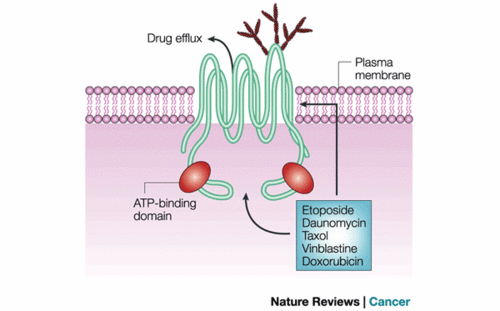Sandbox Reserved 390
From Proteopedia
(Difference between revisions)
| Line 3: | Line 3: | ||
The purpose of this page is to explain a semisynthetic derivative of [http://en.wikipedia.org/wiki/Podophyllotoxin podophyllotoxin] [[Image:PODO.png|thumb|right|50 px|Chemical structure of podophyllotoxin]] (etoposide) that demonstrates antitumor activity by inhibiting DNA topoisomerase II, thereby inhibiting DNA re-ligation which lead to apoptosis of the cancer cell and also, to describe the mechanisms of resistance of etoposide. | The purpose of this page is to explain a semisynthetic derivative of [http://en.wikipedia.org/wiki/Podophyllotoxin podophyllotoxin] [[Image:PODO.png|thumb|right|50 px|Chemical structure of podophyllotoxin]] (etoposide) that demonstrates antitumor activity by inhibiting DNA topoisomerase II, thereby inhibiting DNA re-ligation which lead to apoptosis of the cancer cell and also, to describe the mechanisms of resistance of etoposide. | ||
| - | <ref>doi:10.1038/nrc823</ref> | ||
__TOC__ | __TOC__ | ||
| Line 25: | Line 24: | ||
'''1.''' Decreased accumulation via increased P-glycoprotein (a multidrug resistance): This drug resistance mechanism is characterized by decreased intracellular accumulation of drug facilitated by overexpression of the human multidrug resistance (mdrl) gene, causing overproduction of P-glycoprotein. This cell membrane protein acts as an export pump for a wide variety of unrelated foreign natural products. By maintaining lower intracellular levels of drug, lower drug concentration would be available to the target, which is topoisomerase II. | '''1.''' Decreased accumulation via increased P-glycoprotein (a multidrug resistance): This drug resistance mechanism is characterized by decreased intracellular accumulation of drug facilitated by overexpression of the human multidrug resistance (mdrl) gene, causing overproduction of P-glycoprotein. This cell membrane protein acts as an export pump for a wide variety of unrelated foreign natural products. By maintaining lower intracellular levels of drug, lower drug concentration would be available to the target, which is topoisomerase II. | ||
| - | [[Image:PGP.gif|thumb|right|500 px|P-glycoprotein as a transmembrane drug efflux pump]] | + | [[Image:PGP.gif|thumb|right|500 px|P-glycoprotein as a transmembrane drug efflux pump<ref>doi:10.1038/nrc823</ref> |
| + | ]] | ||
'''2.''' Changes in target proteins: This mechanism relates directly to the target enzyme; Either low enzyme levels or altered sensitivity of the enzyme for the drug confers resistance to that drug. This mechanism also confers a form of multidrug resistance; in that resistance to one topoisomerase II inhibitor through decreased or altered topoisomerase activity generally translates into resistance to most other topoisomerase II inhibitors. | '''2.''' Changes in target proteins: This mechanism relates directly to the target enzyme; Either low enzyme levels or altered sensitivity of the enzyme for the drug confers resistance to that drug. This mechanism also confers a form of multidrug resistance; in that resistance to one topoisomerase II inhibitor through decreased or altered topoisomerase activity generally translates into resistance to most other topoisomerase II inhibitors. | ||
Revision as of 13:06, 3 December 2012
Human topoisomerase II beta in complex with DNA and etoposide
| |||||||||||
References
- ↑ Wu CC, Li TK, Farh L, Lin LY, Lin TS, Yu YJ, Yen TJ, Chiang CW, Chan NL. Structural basis of type II topoisomerase inhibition by the anticancer drug etoposide. Science. 2011 Jul 22;333(6041):459-62. PMID:21778401 doi:10.1126/science.1204117
- ↑ Kathryn L. Gilroy, Chrysoula Leontiou, Kay Padget, Jeremy H. Lakey and Caroline A. Austin* "mAMSA resistant human topoisomerase IIβ mutation G465D has reduced ATP hydrolysis activity” Oxford JournalsLife Sciences Nucleic Acids Research Volume 34, Issue 5Pp. 1597-1607. DOI: 10.1093/nar/gkl057
- ↑ Wu CC, Li TK, Farh L, Lin LY, Lin TS, Yu YJ, Yen TJ, Chiang CW, Chan NL. Structural basis of type II topoisomerase inhibition by the anticancer drug etoposide. Science. 2011 Jul 22;333(6041):459-62. PMID:21778401 doi:10.1126/science.1204117
- ↑ Sorrentino BP. Gene therapy to protect haematopoietic cells from cytotoxic cancer drugs. Nat Rev Cancer. 2002 Jun;2(6):431-41. PMID:12189385 doi:10.1038/nrc823


